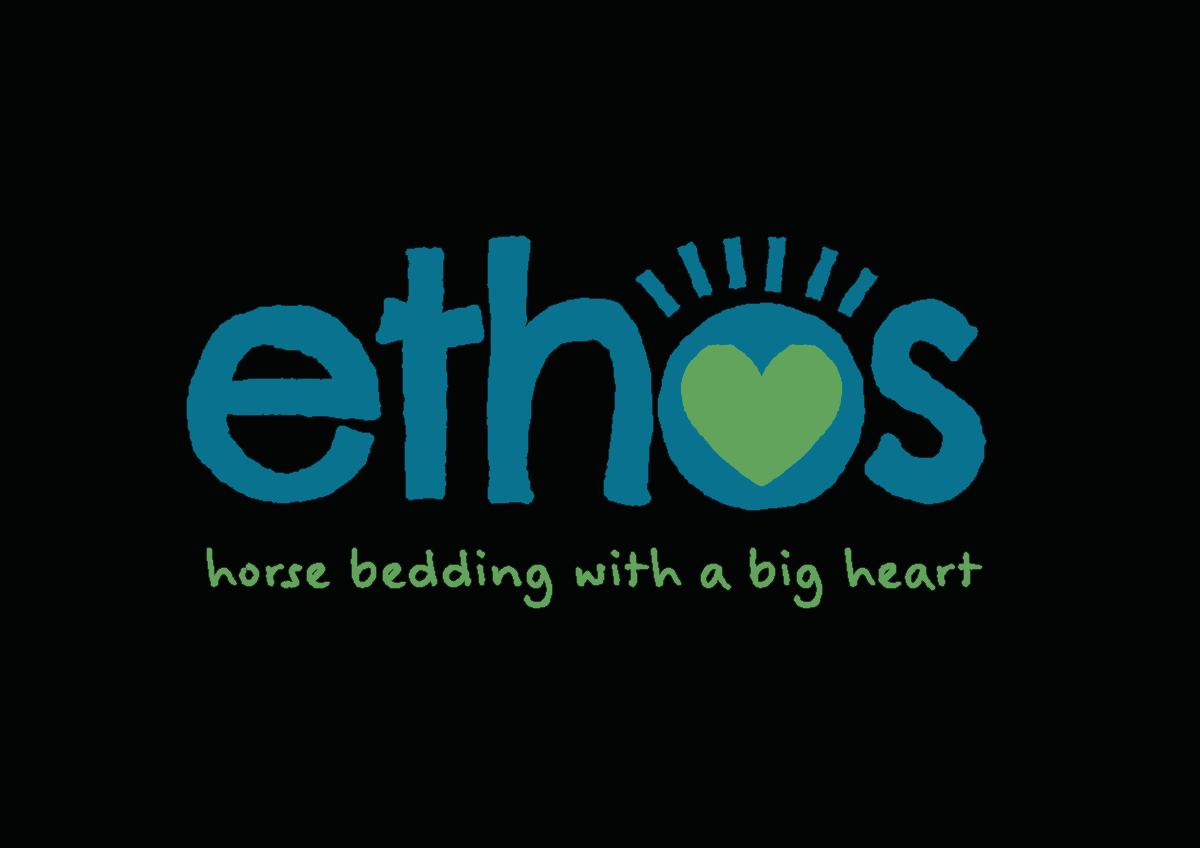Good Welfare? Improving Longevity
Metabolic Issues
Straightforward advice & management tips
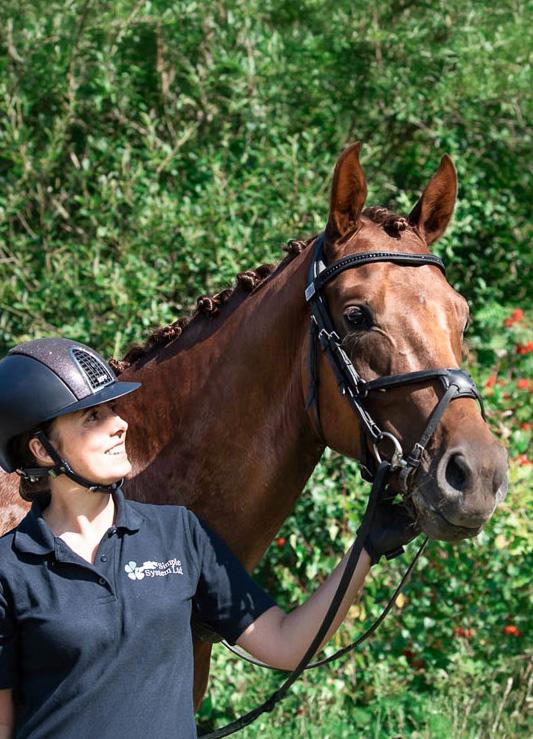
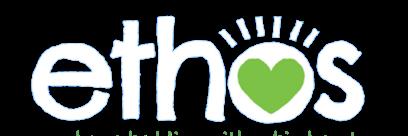

Straightforward advice & management tips


Issue 11
Spring / Summer 2025
Contact Us
Simple System Horse Feeds, Symonds Farm, Newmarket Road, Risby, Bury St Edmunds, Suffolk IP28 6RE 01284 810 043 sales@simplesystem.co.uk www.simplesystem.co.uk
Feed Advice
01728 604 008 info@simplesystem.co.uk
Cover Photo
Frank with Simple System
Supported Rider, Emily Watts Photo credit: RJ Equine Photography
About Simple System
Simple System Horse Feeds is an independent, family owned feed company based in rural Suffolk. The company was founded in 1996 with the aim of producing natural and nutritious feeds that horses were designed to eat. The entire range is free from cereals, molasses, pulses, soya, preservatives and additives.
I can’t recall a time where spring arrived so early, and (for the most part) actually stayed with us. Most horses are now spending more time out so it’s a good time to tend to paddocks. We’ve been working with the experts at Cotswold Seeds to bring a simple guide to ‘Seasonal Pasture Management’. Turn to page 14, where you’ll also find a chance to WIN paddock care products worth over £300! Spring isn’t always as sunny for those who have horses and ponies prone to weight gain or laminitis. As a native pony owner I’m right there with you. Turn to page 8 for advice for ‘Managing Metabolic Horses’ and to page 26 for our ‘Guide to Soaking Hay’. Equine welfare remains in the media spotlight, and quite rightly so, but ‘What is Good Welfare?’. Is it good management? - a
Page 4 : News & Updates
Page 6 : What is Good Welfare?
Page 8 : Managing Metabolic Horses
Page 10 : Tips for Travelling & Staying Away
Page 12 : Donkeys Dietary Needs
Page 14 : Seasonal Pasture Management
theme that underpins all of the articles in this editionor is there more to it? Read more on page 6.
If you’re not convinced you’re getting things quite right, taking a moment to sit and observe your horse can be just the reassurance you need. If your horse looks happy and healthy, they probably are! Still unsure? Remember we’re part of your team - make good use of our expertise by calling the Feed Line on 01728 604 008.
Keep us posted with your adventures this summerI hope it’s a great one! Oh, and I almost forgot - read page 31 for another chance to WIN thanks to our fab friends at Ethos. You won’t want to miss out!
Melody Ashcroft

Page 16: Customer Testimonials
Page 18: Vitamin & Mineral Supplements. Do Horses Really Need Them?
Page 20 : Feeding for Performance
Page 24: Supporting Itchy Horses
Page 28: Forage Feeding for Longevity
Page 30 : Feed Room Fun and a chance to WIN!!!

Frank joined Emily’s herd in 2024 - in fact he was her 30th Birthday present!
Frank is just 5 years old and whilst bred by Matt Frost for dressage, he currently enjoys hacking around the lanes and the occasional session in the arena. Emily is a big believer in allowing young horses the time to develop and strengthen in their own time.
Emily says ‘‘Secretly, I am really excited by him and he has the best temperament of any horse I have ever ridden. I hope to have a long, happy future together’’.
Frank’s Simple System diet is Sainfoin Pellets, Sainfoin & Shine and Veteran Balance +®.
Although Frank is only 5, Emily chooses Veteran Balance +® for its natural joint support and vitamin and mineral top-up.
Frank & Emily feature on our Sainfoin & Shine packaging!




Simple System’s Managing Director, Oli Harris, is swapping his steel toe caps for trainers this April as he runs the London Marathon in aid of Retina UK - the only UK charity dedicated soley to working with inherited sight loss.
Oli is partially sighted due to a genetic eye disorder he has had from birth. ‘‘I have always been very fortunate to have been surrounded by people who don’t see my level of eyesight as a barrier.’’ says Oli. ‘‘Through the many hospital appointments over the years, I’m always most affected not by my own diagnosis or results, but rather the other people in the waiting room. Sadly, there’s always someone for whom this is new, life changing information. Barriers are building around them before even leaving the hospital. Thankfully, there are charities and NHS staff that offer much needed support. Retina UK play a crucial role, investing in medical research and offering invaluable support for those with inherited sight loss.’’
“I’m really looking forward to the challenge. Simple System principles for horses in work apply to endurance runners too. In essence I’m target feeding before the race and topping up on fuel and the salt lost throughout!”

Received fantastic advice from our Feed Line or found our advice articles helpful? Please consider nominating us for the ‘Nutritional Helpline of the Year Award’. It would mean the world to our team.
Nominations take just a few moments and you can do so by scanning the QR code below.

You can also nominate your local retailer to receive an award, so if your Simple System stockist has been simply super in the last twelve months, please help them gain the recognition they deserve - head to beta-uk.org/awards.
Each year, Heald Town Highland Pony Stud sell calendars and cards in aid of grass sickness. This year they’ve added over £2500 to the pot bringing their total to over £25,000 to date!
Our team are excited to have some of our favourite events booked in the diary this season.
We do hope you’ll be able to join us!
Ellen Lincoln BSc. (Hons), MSc., who is pictured opposite with her rescue horse, Indigo, has recently been promoted to Nutrition Manager!
Ellen is highly experienced, having worked on the Simple System Feed Line for almost five years, and prior to that has worked at dressage, eventing and racing yards. She also spent several years at Newmarket Equine Hospital looking after more clinical cases.
‘‘Ellen’s impressive qualifications, dedication to the needs of horses and great empathy with their owners, will enable her to flourish in this role.’’ says Jane van Lennep - Simple System’s Director of Nutrition and Co-Founder.
The whole Simple System team couldn’t be happier to see Ellen in her new role, and we’re sure that our customers will be keen to join us in congratulating her on the new position.
If you’d like advice from Ellen and the Feed Line, call 01728 604 008 or send an email to info@simplesystem.co.uk.
Strangles Awareness Week (SAW) is a collaborative campaign, brought together by Redwings Horse Sanctuary, that aims to bring the country’s most common infectious equine disease - strangles - into the spotlight.
For 2025 the campaign needed a mascot - and who better than the lovely Redwings Indigo, who lives with his rehomer - the Feed Line’s very own Ellen Lincoln!
In early March, Indigo had the first of two strangles vaccines and took part in a photo and video shoot, ably assisted by Ellen. We can’t wait to see the result, but like everyone else, we’ll have to wait until the campaign begins in May.
To find out more about strangles, how to help reduce the risks, and to learn how you can get involved in Strangles Awareness Week 2025, visit redwings.org.uk/strangles
10th-13th September
BEVA Congress
ICC Birmingham, B1 2EA www.bevacongress.org
We’re excited to be attending lectures, as well as exhibiting for equine veterinary professionals at congress for the third consecutive year.
Since launching MalleMash® back in November 2023, it has become a firm favourite for many horses - especially so for natives, cobs and feathered breeds. MalleMash® now has its own dedicated bag featuring a beautiful traditional mare, Bessie.
If you’re not yet familiar with MalleMash®, it’s a comprehensive high fibre mash, rich in omega 3, low in sugar and starch to provide dietary support for equines with dry or itchy skin.
It is also a convenient feed for good doers. For those with large appetites, pair with Timothy Chop to slow eating rate.

To find a stockist, or to buy online with free delivery, visit www.simplesystem.co.uk.
We’re delighted to have welcomed lots of new retail stores recently. Here are just a handful who have recently joined the Simple System stockist family...
Brambledown Farm Shop | Sheerness, ME12
Cornwall Countryside Supplies | Truro, TR4
Equi Relief Feed & Tack Shop | Fife, KY5
Equine Nutrition UK | York, YO60
Frosburys Equine Supplies | Guildford, GU3
Heart Pet Supplies | Exeter, EX5
Lavender Dog Shop| Alfreton, DE55
Lears Equine Supplies | Wigan, WN2
Naylors (Go Outdoors) | Multiple locations
Pasturetec | Willington, DE65
Spinney Farm | Lowestoft, NR32
Stanah Horse Feeds | Thornton-Cleveleys, FY5
To find your closest retailer head to www.simplesystem.co.uk, click ‘Stockists’ at the top of the page, and enter your postcode.
7th - 9th November Your Horse Live NEAC Stoneleigh, CV8 2LZ www.yourhorselive.co.uk
A favourite event for the Simple System team, and this year is set to be better than ever as we have plans for a very special celebration! For Customers For Vets
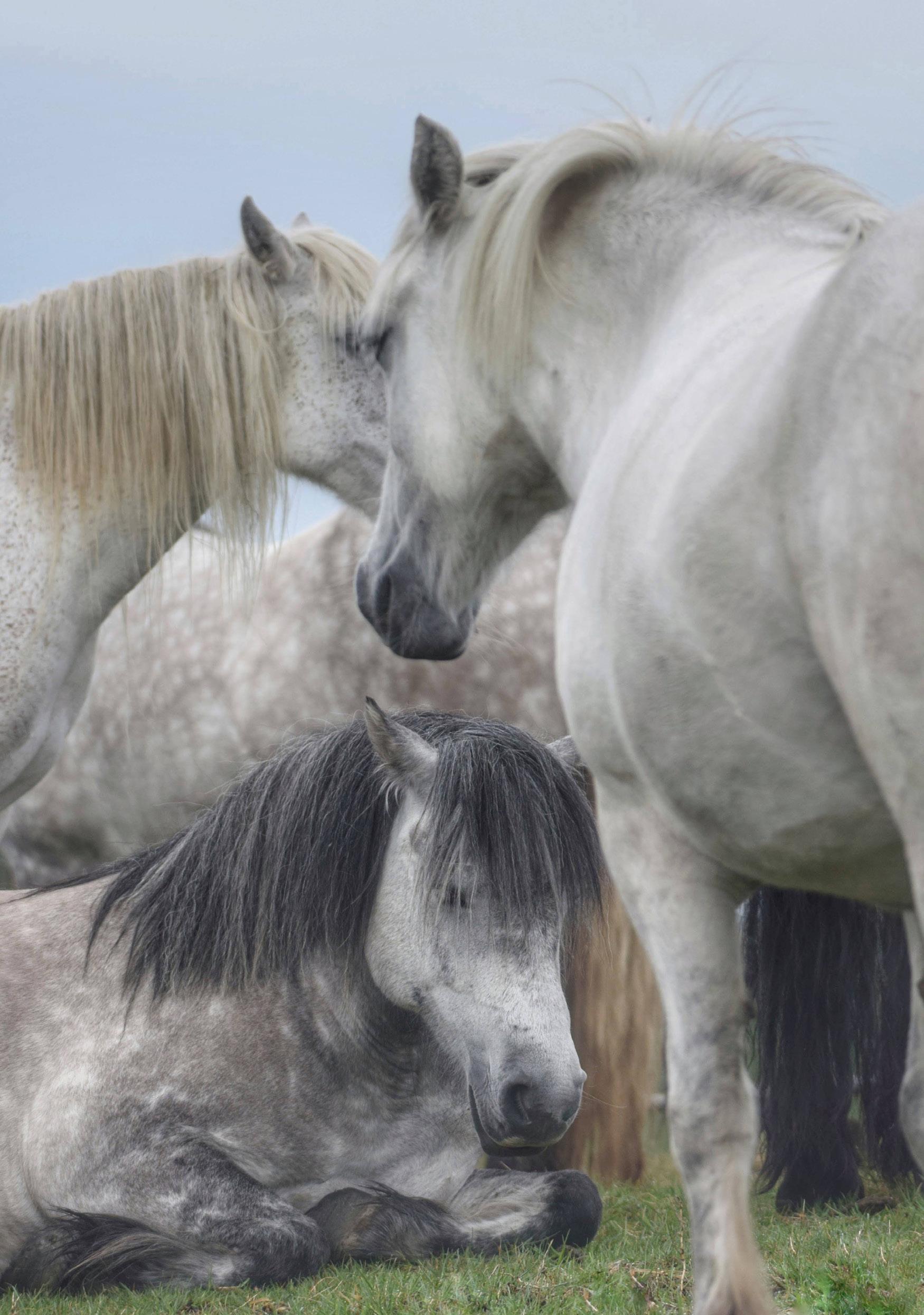
Friends demonstrating natural herd behaviour at Heald Town Highland
Jane van Lennep BSc., MSc., BHSI (SM Cert), NPSD | Director of Nutrition |
My niece came home from primary school with a work sheet about animals. A picture of a horse looking over a stable door was captioned “I am a horse. I live in a stable and I eat oats and hay.’’ Oh dear! Whilst for many horses this is a sad reality, it is very far from delivering good welfare.
Increasingly, we are all more aware of the 3 Fs – friends, forage and freedom, to address the needs of a horse as herd-living, plains dwelling, obligate herbivore. However aware of the 3 Fs we are, putting them into practice isn’t always achieved, maybe because the implications are not well understood?
Friends, because horses are herd animals and need to socialise and support each other. It is not good welfare if their “friend” is the other side of a fence or only visible by craning their neck over the stable door. Friends need to share space, look out for each other, stand watch to allow a rest, groom and play.
Forage is not just a rationed amount, fed twice a day. It’s access to it at all times. A horse will become stressed if they cannot eat, and if they’ve not eaten forage for just 2 hours will suffer discomfort, or worse in work. After 4 hours of fasting, the risk of colic increases as well as ulcers, including those around the pyloric valve from the stomach to the small intestine, as bile can back-flow when it builds up in the duodenum. Forage is usually hay or grazing, but will also include dried forages, which may be offered soaked or chopped, such as grass, lucerne and sainfoin. Grazing is the best way to offer forage, but we can be very nervous of grazing for metabolically challenged horses. We give them hay, but hay is dried grass. The difference is that we all too often graze very short grass whereas hay is typically made from longer, more mature grass. This grass makes for much safer grazing.

Freedom is the space to gallop, breathe fresh air, interact with friends and access the best forage.
Good welfare is meeting the horse’s actual needs, not necessarily our perception of what we think is good welfare. Is it good welfare to shut a horse in a stable because it’s raining or to isolate them from companions? To offer processed food made from ingredients never encountered during their evolution? It is a sad fact that our misplaced endeavours to do right by our horses can actally be doing the opposite, exposing them to the same triggers for ill health that are currently experienced by humans – inflammatory conditions, metabolic issues, allergies and sensitivities.
Improving welfare and improving access to those ‘3Fs’ will result in our horses being happier, healthier and able to live longer more comfortable lives. A sore and elderly horse, in a small pen for a few hours and isolated in their stable with a restricted diet for the rest of the time, is not enjoying good welfare - however well loved they may be.
Welfare does not end with how we care for our horses. Breeders take responsibility for producing sound horses with good temperaments, fit to do the job they were bred for. However, for those that do not quite make the grade, what future for them? Highly bred performance horses may have more courage than an amateur needs, or can cope with, yet does not have the ability to fulfil the requirements of a competitive rider. What future then? In-bred horses of extreme type may not deliver issues for their breeder, but any subsequent owner may have soaring vet bills due to reduced immunity, metabolic issues, skin disorders and so on. Expensive, yes, but also impacting on the horse’s welfare.
Describing a horse as “metabolic” is a commonly used umbrella term – it may mean that they have Equine Metabolic Syndrome (EMS) specifically or, Pituitary Pars Intermedia Dysfunction (PPID). They mab be prone to laminitis; have Insulin Dysregulation/Resistance (IR); or struggle to maintain normal, evenly distributed body condition, often developing fat pads and a crest, even when they are a healthy weight otherwise. NB. For the purpose of this article, we are not referring to the metabolic issues linked to prolonged exercise that may affect Endurance or performance horses.
Whilst metabolic disorders are often associated with older horses, they can affect horses from a young age as well as those in even very high levels of work and fit body condition - especially if they have a genetic or breed predisposition.
What metabolic horses will all have in common is that they need stricter management than your average horse, often with careful consideration of their sugar and starch intake. But, like all other horses, they still need quality protein, sufficient fibre intake and balanced vitamins and minerals.
Most “metabolic” horses will be kept on limited or restricted grazing especially when grass is actively growing and around frosty weather which can spike sugar levels. Some may even be kept off fresh pasture altogether and be housed on a dry lot turnout, such as a bark paddock or a surfaced track and have a solely hay-based diet.
The lack of fresh pasture intake increases the need for quality protein, omega-oils and a vitamin/mineral top-up which is where a specially designed balancer such as MetaSlim® can be utilised. Pairing this with a naturally low sugar forage chop such as Organic Lucie® Stalks provides a nutritionally appropriate feed that being forage- rather than straw-based, is a vitally important source of protein for those on restricted diets.
Protein is not just used for muscle building but helps maintain hoof integrity and is involved in virtually every bodily function necessary to sustain life - not just good health.
Measured out diets of soaked hay can mean your horse is at risk of having insufficient dietary protein – as a minimum for those convalescing or in light work, protein intake should be 8-10% of the diet. Soaking hay for long periods can strip out this vital nutrient making it even more important to top-up it up in the feed bowl.
Whilst Organic Lucie® Stalks will sustain the good doer, the underweight metabolic horse will benefit from more nutritious legume feeds, such as Lucie®Nuts or Organic Lucie®Pellets to supply higher levels of protein but still offer a suitably low sugar and starch level.
Back to the thing people worry about the most: sugar and starch...
Starch intake is easily reduced in the diet when forages are fed rather than cereals as plants tend not to store their own “energy” in this way.
Sugar is naturally occurring in all forages but at Simple System we never add more sugar in. We do not use molasses, syrups or sugary sweeteners. Added and refined sugars such as these dissolve in the horse’s saliva and are rapidly absorbed into the blood stream. This can be a problem for metabolic and especially IR affected horses who may end up with both high sugar and high insulin levels in the blood, which increases the risk of laminitis.
Some forages have more sugar than others, and although this sugar is within the cells of the plant and will be released more slowly, it can still cause a problem. Grass tends to have more sugar than other plants and ryegrass often has more sugar than other grasses which is why we suggest avoiding it – and do not use it in any of our feeds.
Our grass-based feeds usually have sugar levels in the range of 5-10% whilst in comparison, lucerne and particularly that grown in the UK and Europe as opposed to America (where they use the term alfalfa) has a reliably even lower sugar level, in the range of 3-7%. This makes lucerne an even more appropriate feed for horses with metabolic issues - hence its use as a forage base in MetaSlim®.

Ellen Lincoln, BSc. (Hons), MSc. Nutrition Manager | ellen@simplesystem.co.uk
MetaSlim®
A balancing feed created for those challenged by weight and metabolic issues.
Organic Lucie® Stalks
Our lowest calorie chop - ideal for bulking out the feed bowl.
Lucie® Fibre Cubes
High fibre, low calorie lucerne pellets to provide natural vitamins & minerals.
A favourite for cobs and native types.
Lucie®Nuts
An ideal option for those needing higher protein levels, but low sugar and starch.
12mm pellets soak to form a tasty mash.

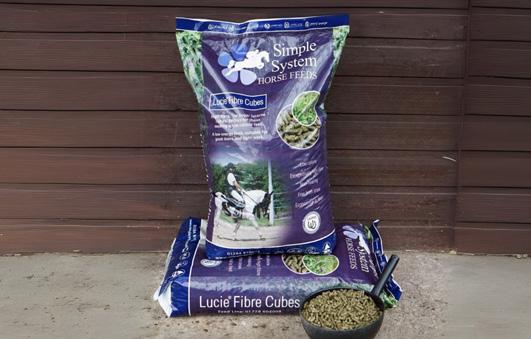
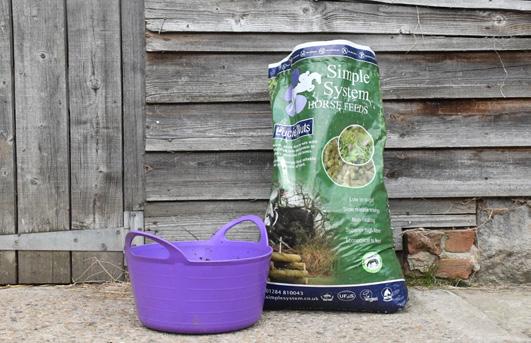
Organic Lucie® Pellets
Planet-friendly and ideal for those on organic farms / yards.
Nutritionally similar to Lucie®Nuts, but in a 6mm pellet form.

With the popularity of camps, farm and pleasure rides on the rise*, it’s not just competition horses that will be boxing-up, heading out and staying away from home this summer.
When travelling with horses it is important to remember that they are under more stress than usual. Horses should travel with food, even on short journeys. Whatever forage is used, offer it from as low a position as is safely possible. Your horse should be able to lower their head to aid the clearance of airways, promoting good respiratory health.
The risk of dehydration increases when travelling. It makes good sense to take a break in the journey every two hours or so to offer a drink (both plain and salted water), and a soaked forage feed.
Something often overlooked is that travelling itself is a piece of work.
Travelling uses as much energy as the same time spent walking briskly. If you’re travelling and working your horse on the same day, they will require a greater energy provision.
Ideally, when we are away, we will offer the horse the same feed they are used to, and probably in larger amounts. In reality, multiple bags of different feeds may not be practical when short of space in the lorry.
SimplyComplete is a ‘one bag’ feed, originally formulated with travelling and events in mind. It contains: lucerne, beet pulp, forage balancer (linseed meal, seaweed and Brewers’ yeast), salt and mint. It can be fed to a crumble type consistency with 2.5 times its volume of water, or you can make a sloppy or soupy mash for recovery and re-hydration.
Target Feeding provides a more direct energy source and creates a fibre mat to help line and protect the stomach.

Horses use as much energy when travelling as they do at a brisk walk!
* Data Source - Simple System Survey 2024 / 2025
SimplyComplete (and all Simple System feeds), can be Target Fed right up until the moment you mount.
When staying away, keep to your horse’s usual routine as much as possible. It may be necessary to work in extra feeds, walks out and hay if they are not getting turn out. Their am/pm feeds should be as close to their normal time as possible, as should their usual quiet time - rest is important!
Being away from home can make your horse unsettled. If they will eat their ‘short’ feed, so long as it is forage, give them plenty of this. It’s not unusual for horses to be off their feed or hay if they are stressed so consider alternative hay replacement options such as HayCare®, dampened Timothy Chop and Simple System Brix. This offers variety and allows natural browsing/selection behaviours - aiding enrichment and reducing boredom. Introduce this in the week before the event and phase back out again when at home.
If your horse doesn’t drink well away from home it is even more important to offer soaked feeds. You can also consider damping hay, or buckets of a suitable chop such as Timothy Chop to keep fluid intake up. Offering flavoured water, soaked HayCare® or PuraBeet can all be helpful for poor drinkers. Again, introduce any changes gradually.
No matter how well managed, some horses will drop weight at stayaways. Be sure to increase their feed intake during the stay, and remember that they may need this higher level of feeding once they have returned home to re-build what has been lost. Their feed may require tapering up and back down, before and after the event.
If you have any questions about feeding your horse when away from home, the Feed Line are happy to help. Call on 01728 604 008 or email info@simplesystem.co.uk.
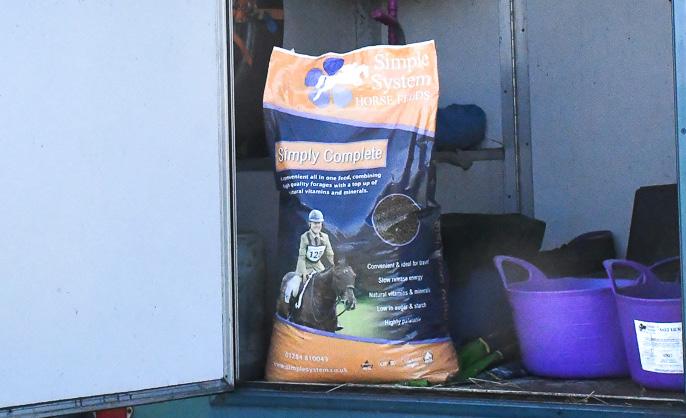
Formulated to suit the demands of competition, this space saving ‘one bag’ feed is ideal for Target Feeding at shows and events. Feed soaked as a crumb, or add extra water to make a soupy mash for recovery & rehydration.


Simple System Brix

Timothy grass hay replacer with nutrition likened to good quality, high fibre hay.
Feed soaked at ground level, pre and post travelling for hydration and respiratory health.
Available in 3 forages; grass (MeadowBrix), lucerne (LucieBrix) & sainfoin (SainfoinBrix).
These handy blocks offer a portion of compressed forage and are ideal for enrichment and variety.
Donkeys have an even greater requirement for fibre from forage than horses. They are usually “better doers”, having evolved in much harsher conditions.
For donkeys, select forages from our range which are lower in calories and higher in fibre:
Organic Lucie® Stalks or Timothy Chop are ideal chops for those with good dentition for chewing.
For older donkeys, or those who struggle to chew, Lucie® Fibre Cubes, HayCare® and PuraBeet are easier to manage soaked alternatives.
Lucie®Nuts can be used as the base feed for young, growing or underweight donkeys, but avoid overfeeding. Regular body condition scoring is useful to monitor condition. Once a donkey has developed fat pads, they will rarely (if ever) lose them as donkeys are highly susceptible to Hyperlipaemia.
A balancer can also be useful as donkeys often have a dry coat. Simple System’s Total Eclipse, which is based on full fat cooked linseed, is perfect – and has the advantage of being effective in small amounts and thus low calorie. Free access to a plain salt block, such as our Salt Lick Tub should also be given.
To manage donkeys the same way as horses and ponies is unfair on their careful evolution as they are cleverly adapted to digest very high fibre, low feed value roughage. This difference in digestive capability is evidenced through distinct differences in their hindgut ecosystem and the range of microorganisms present (Edwards et al., 2020). As a result, donkeys have an even more innate desire to trickle feed and obtain high fibre intake, and they can become quite destructive if this need is not met. Providing access to safe trees and hedgerows, or branches and cuttings from these, can help increase environmental enrichment and reduce wood chewing.


Simple System’s lowest calorie chop made from nothing but the high fibre stalks of the lucerne plant.
Feed dampened for those with good dentition for chewing.
Salt should be available at all times, for all equines - including donkeys.
This pure white salt lick comes in a reusable flexi-tub and is ideal for field or stable use.

‘‘My boys love their Simple System dinner!’’
A high fibre Timothy Grass chop. Harvested at a mature stage for naturally low sugars.



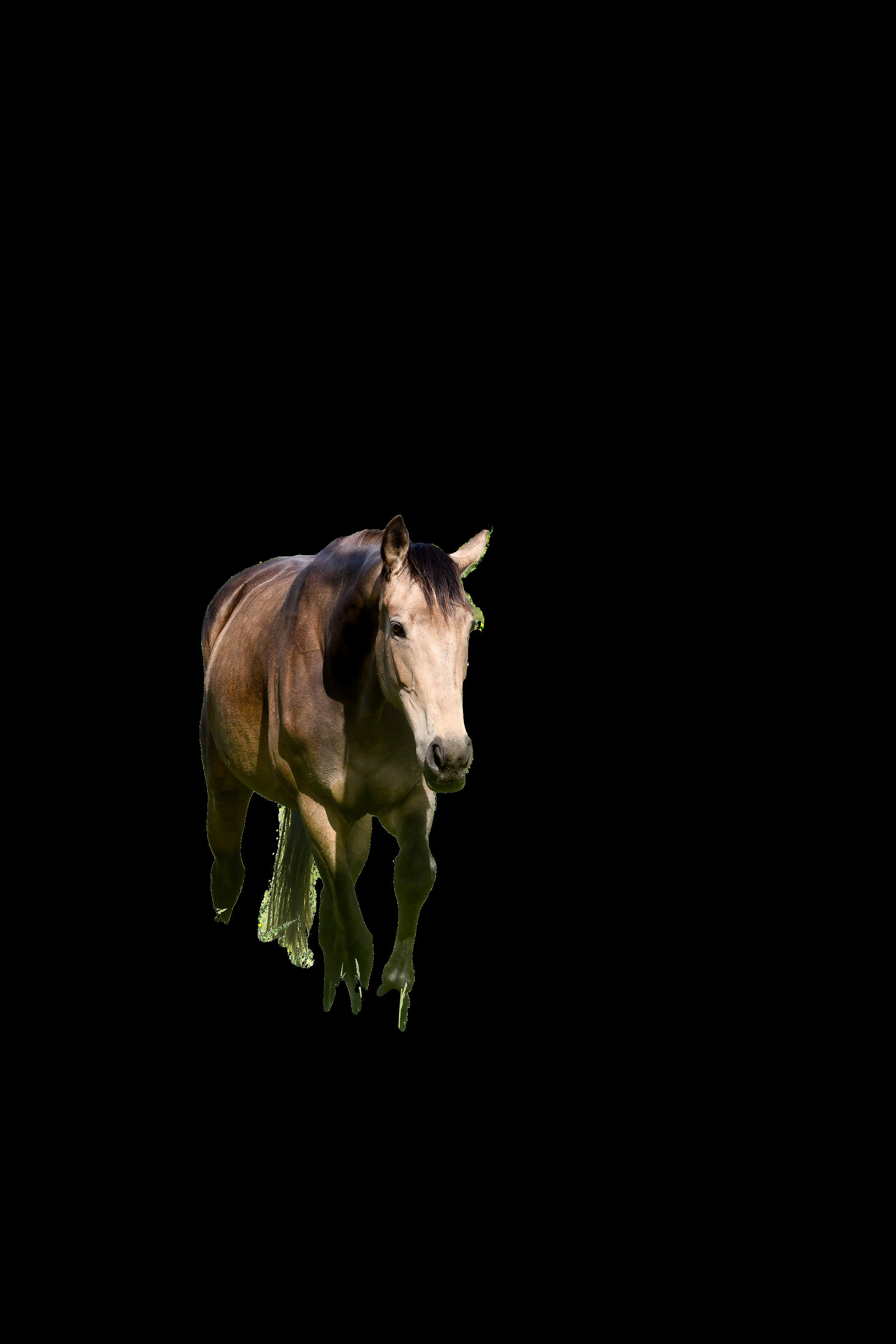
Managing pasture efficiently throughout the year will give the very best chance of producing a healthy, productive grazing environment.
During early spring, before the grass starts growing too vigorously, is a good time to reseed the patches in your pasture that have been stripped or churned up during winter. A little extra seed spread in spring can make a notable difference to your grazing. There is not often any need to plough up and reseed from scratch.
If you are overseeding, we suggest choosing a ryegrass free mix of native type grasses and legumes, such as Natural Grazing Mix - created by Simple System specifically for horses, and can be purchased directly from www.cotswoldseeds.com.
Here are some seasonal suggestions from the seed experts at Cotswold Seeds, to enable you to gain the most from your grazing...
Winter (December, January & February)
• Paddocks should not be overstocked wherever possible, to avoid poaching and damage to existing grass.
• Areas that do become poached should be fenced off to avoid too much compaction and waterlogged ground i.e. around gateways.
• Soil analysis can take place in winter to assess pH and soil nutrients.
Spring (March & April)
• When the ground has dried enough, chain harrow the pasture. This removes any dead grass, evens out poached areas and allows air to the grass to help with spring growth.
• An assessment of the field should be carried out to decide if the grass would benefit from overseeding or if the field may need to be reseeded.
• Pasture treatment or fertiliser can be applied in spring when the grass begins to grow. If needed, seek expert advice on what your requirements are, ensure that a slow releasing product, such as Simple System’s Natural Paddock Recovery, is used. The slow release of nutrients will help the grass to grow at a more steady rate - essential for those prone to metabolic issues and laminitis.
• If overseeding is not required, roll the pasture when the conditions are dry enough. This will encourage tillering of the grass plants and encourage a healthy root structure.
Natural Paddock Recovery
A natural, horse-safe lime and polyhalite pasture treatment used to restore vital minerals and to balance pH levels in acidic pasture, promoting healthier grass growth.
Order online at www.simplesystem.co.uk

This ilustration demonstrates root depths of the plants included in Natural Grazing

• Prepare the ground following the recommendations from soil analysis.
• The timing of the overseeding is important as it is not advised when grass is growing vigorously (May, June). The ideal time to sow is between March and April, when ground temperature should be above 6°C. The pasture should have been cut or grazed hard before sowing.
• If the sward is open, the seed can be broadcast by hand after chain harrowing. If a large area is being overseeded a drill may be used but grass seed must not be planted too deeply.
• After seeding, the ground should be consolidated either by rolling or, for an environmentally friendly alternative - by grazing with sheep.
• If applying nitrogen, application should not occur until the new grass has established.
• Horses can be turned out approximately 6 weeks after overseeding but only to lightly graze. If it is practical to do so, leave the pasture free from horses for an extra few weeks to allow the roots to become better established.

To discuss your paddock requirements, the team of experts at Cotswold Seeds are available to help on 01608 652 552. Deep rooting legumes, such as sainfoin, promote

Quality forage for horses begins in the field. As such, we’ve partnered with the growing experts at Cotswold Seeds to give you the chance to WIN!!!
To help spruce up your pasture, the prize includes...
Restores vital minerals, balances pH levels and promotes healthier grass growth. This paddock treatment is 100% natural and safe to apply, even when horses are grazing.
A ryegrass free, high fibre forage mix that is ideal for adding variety and diversity to equine pasture. Created by Simple System for the benefit of horses and produced by Cotswold Seeds.

For your chance to WIN, enter by scanning the code above, or by visiting www.simplesystem.co.uk/paddockcomp
Be sure to leave your contact information when completing the entry form, as we’ll need to notify you if you’re the lucky winner.
T&C’s available at www.simplesystem.co.uk.
Share your story for a chance to feature visit www.simplesystem.co.uk and click the ‘Testimonials’ tab
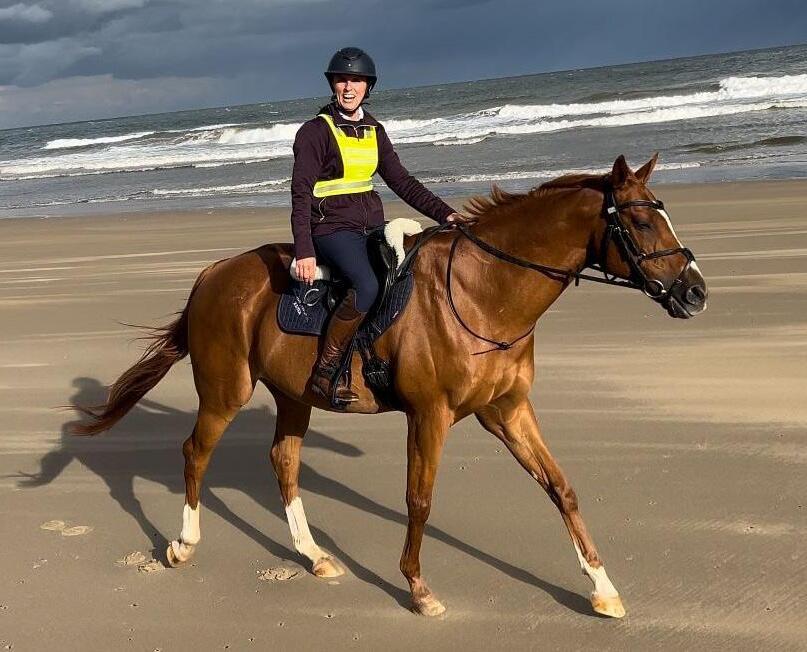

‘‘It’s the best Oakey has ever looked!’’
‘‘Having owned Oakey for 11 years, feeding has always been difficult. Whether that was because he wouldn’t eat what he had been given, or he just wouldn’t hold weight, or I was having to feed him buckets and buckets!
I took Oakey barefoot just over 2 years ago, completely changing how I manage him. Feed was a huge part of this journey and we tried a few things before finding Simple System Horse Feeds.
He instantly loved Sainfoin Pellets with his FlexiBalance!
Oakey lives out all year, he comes in for a few hours a day to eat and rest. Along with his all round management and finding the correct natural feed, it’s the best he’s ever looked. He now never leaves anything in the bowl.
Thank you Simple System for everything!’’
Danielle Noble Simple System Customer


FlexiBalance
Our ultimate forage balancer, offering a top-up of vitamins, minerals and prebiotic - plus natural joint support.
The ideal balancer to aid flexibility and range of movement. Suitable for all ages and workloads.
Sainfoin Pellets
A premium forage alternative to grass or lucerne / alfalfa, rich in natural minerals, trace elements and condensed tannins, which can aid the digestion of protein.
Sainfoin is very palatable, making it a great choice for fussier feeders.
‘‘Daisy is allergic to life! Wheat, oats, straw, garlic - even her own sweat!
She was very itchy and would rub herself raw.
She has been treated by my vet and is now fed a Simple System diet of MalleMash® & Calm Balance + ®.
You can really see the shine from within and how much her coat has improved.’’
Charlie Tyson
Simple System Customer

Daisy’s Feed Plan...

MalleMash®
Recommended by Abi on the Simple System Feed Line as it free from the ingredients that Daisy is known to be reactive to. MalleMash® is also soya and GM free, and has a high inclusion of linseed for essential omega 3 to support dry or itchy skin.
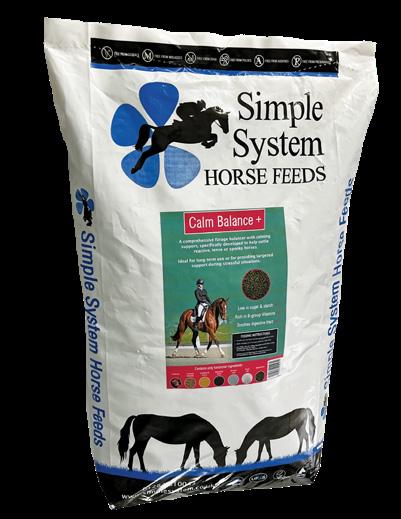
Calm Balance + ®
Chosen by Daisy’s owner, Charlie, as an addition to the diet for calming support .
Alongside its other natural, functional ingredients, Calm Balance +® is pelleted with sainfoin - a highly popular forage choice for allergy prone horses.
‘‘ The only horse feed company to give me full confidence’’
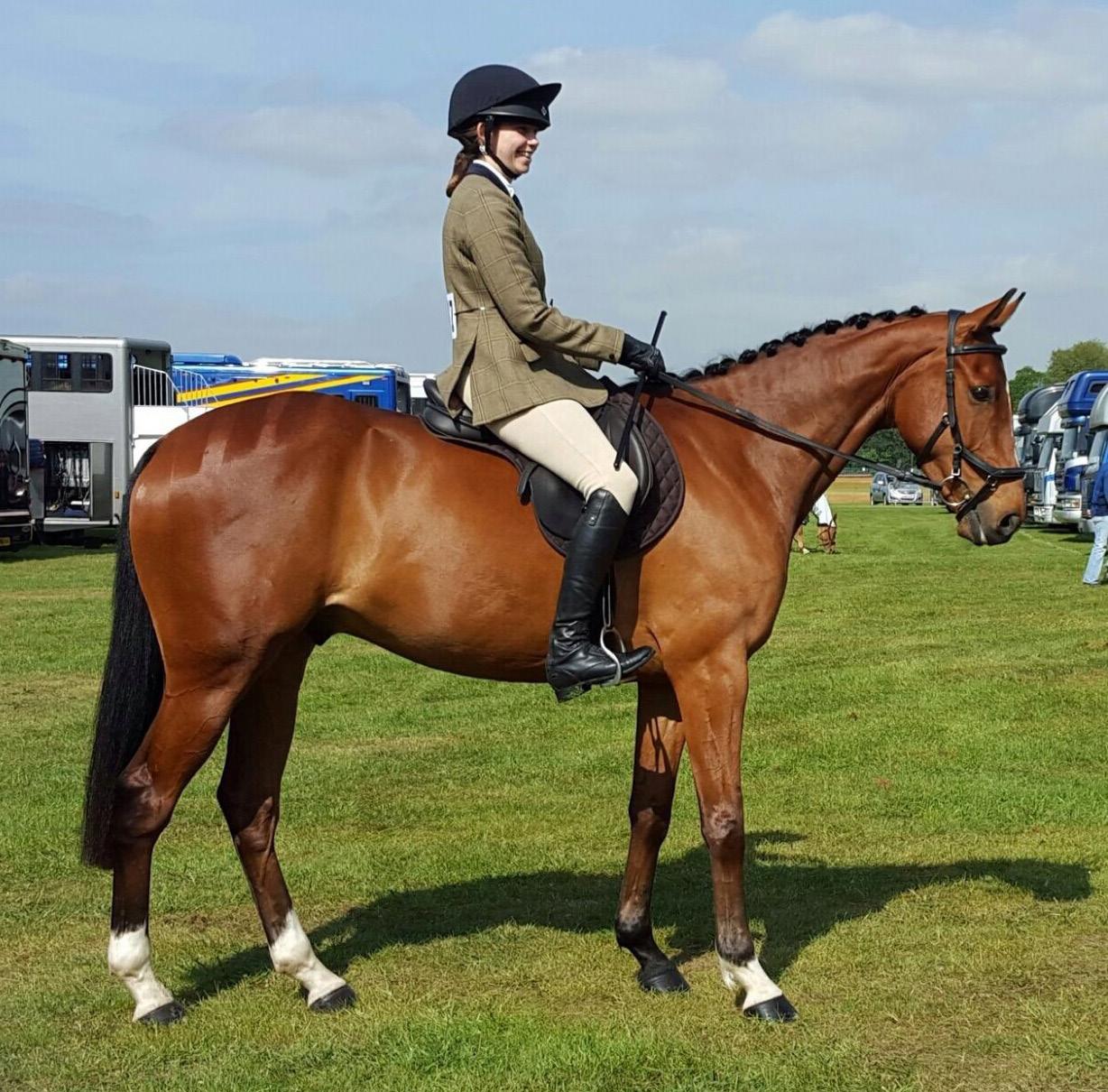
Archie’s Feed Plan...
Sainfoin Pellets MeadowBrix

Pure Timothy grass compressed into handy blocks. Useful for variety and enrichment.

‘‘My thoroughbred, Archie, has fairly severe allergies to ryegrass - unfortunately this features in a lot of feeds!
Simple System are the only horse feed company who gave me full confidence in their products, and what they contain.
We are able to use the sainfoin and Timothy products safely and even better that they come in so many different forms! We love the MeadowBrix for extra enrichment.
We recently tried the new Sainfoin & Shine and will be continuing to use this as a Target Feed, and to encourage chewing, as part of his ulcer prevention management.’’
Hayley Jupp
Simple System Customer
Sainfoin & Shine
Chopped sainfoin with cold pressed linseed oil. Slows eating rate, encourages chewing and saliva production.


We can spend a fortune on vitamin and mineral supplements and are loath to stop any in case that was just the one that was doing some good. But, do horses always need vitamin and mineral supplements?
The horse’s natural diet is forage. Their daily greens are full of vitamins and minerals, the oils they contain are high in essential omega 3 and the fibre, especially in younger plant material, is easily utilised by the gut microbes.
When forage wasn’t available in sufficient amounts to meet the requirements of working horses, a concentrated form of energy was needed and cereals came into play. Oats were chosen as being “ideal” as they have more fibre and oil than other grains. Really, we should say that oats are the least bad, rather than the best!
All cereals lack the vitamin and mineral levels found in forages. They also lack calcium but have surplus phosphorous. When cereals and other by-products are used as the basis of a horse’s feed, supplementation is likely to be necessary to make up for their deficiencies. Also, if a horse is a good doer and does not need recommended amounts of a feed, further supplementation may be needed.
Going back to the beginning, the forage fed horse shouldn’t require supplementation - so long as the forage is good quality. Modern drying methods ensure that spring and summer growth can be dried quickly, preserving the nutrition for the winter when it is needed. The only thing lacking in quality forages is salt. Leaving a Salt Lick Tub in the field or stable, allows horses to self-regulate their intake.
At Simple System we typically suggest feeding a pellet, chop and balancer from our range to provide the vitamins and minerals your horse requires to thrive - alongside their usual grazing and hay.
A quick re-cap on vitamins and minerals... Green forages are a wonderful source of Vitamin E and beta carotene, which the horse can convert into Vitamin A; B group vitamins and Vitamin K are made by the gut microbes; horses make their own Vitamin C in their liver; Vitamin D is made by the horse in sunlight and is in hay.
The levels of essential omega 3 can decline in even the best made hay, so there can be a case for supplementing with a good source of this important nutrient (Instant Linseed).
Shallow rooting grasses may not be able to access sufficient minerals, in which case, topping up with a good quality seaweed (Pure Organic Seaweed), nature’s own mineral supplement, can bridge this gap.
Adding stabilised yeast (Traditional Brewers’ Yeast) can help support the gut microbes as well as being a good source of nutrition. For a top-up of all of these, consider adding Total Eclipse to the diet. These are all natural sources of “supplementation’’ which are easily digested and well assimilated.
It is also beneficial to consider adding deeprooting legumes to the diet, such as lucerne or sainfoin. These forages provide variety, have their own unique benefits for horses (lucerne with its acid buffering calcium and sainfoin with its condensed tannins, which can aid the digestion of protein) and, they take up more nutrients from the soil than shallower rooting plants, such as grass.
If you suspect a vitamin or mineral deficiency, contact your vet in the first instance. Often the vet will undertake bloodwork investigations to aid diagnosis. It may also be necessary to conduct a mineral analysis on their grazing or hay, as this will be the main source of intake and will have the greatest effect on deficiencies. For dietary advice, contact the Feed Line on 01728 604 008.






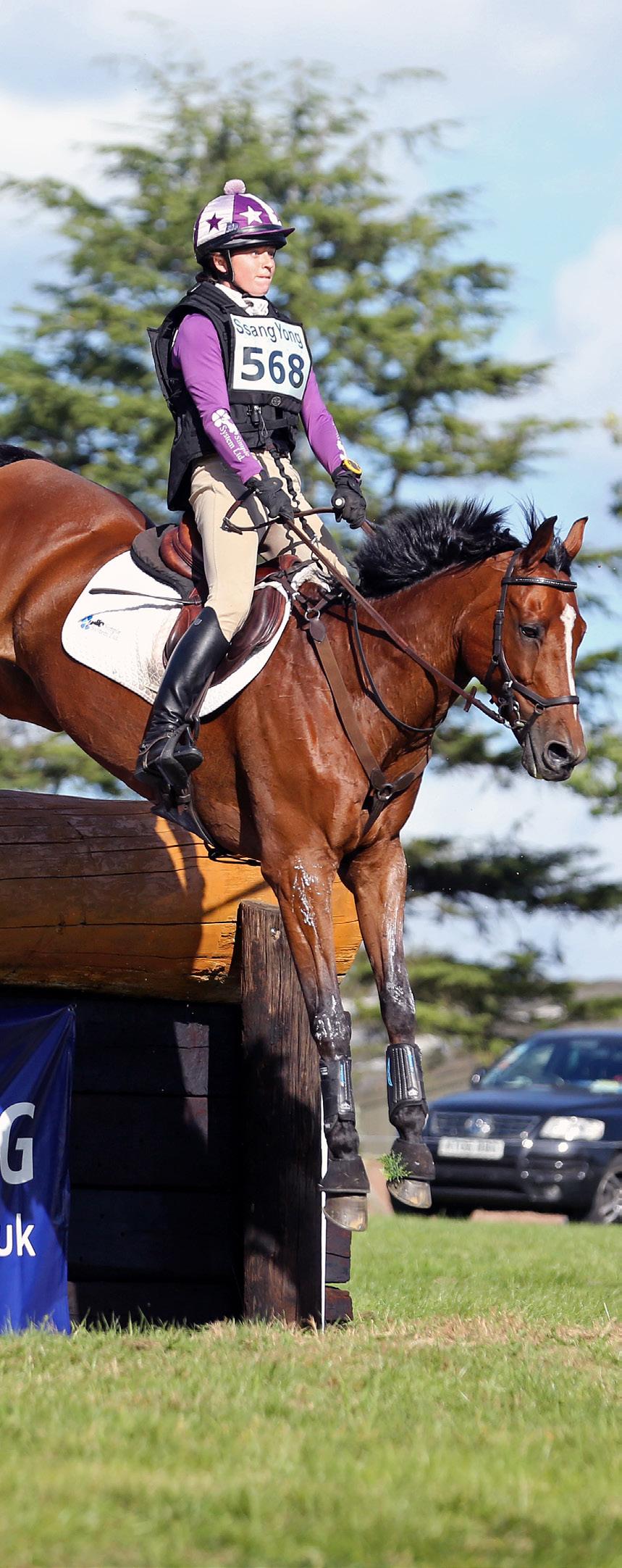
Jane van Lennep, BSc., MSc., BHSI (SM Cert), NPSD Director of Nutrition | info@simplesystem.co.uk
Simple System supported horse and rider combination, Sjapo le Sursaut and Georgie Wood.
Whatever the work, we mustn’t lose sight of the fact that we are feeding a horsebeautifully engineered over the last 30 million years as a plains dwelling, herd living, obligate herbivore that had the option to browse and graze a variety of grasses, herbs and legumes.
The horse’s gut is still a simple, one-way system; the caceum and colon are still huge and brimming with essential microbes; the digestive juices are still low in amylase (which is required to digest starch), and the stomach still needs topping up with food, frequently.
Interestingly, the performance demands we make of our horses are quite unlikely to exceed the demands of a wild horse in the spring, producing and feeding a foal and regaining weight lost during a harsh winter.
When it comes to fittening, the first thing we tend to do is stable our horses, but then do lots of walking to start the fittening process. Perhaps a strange concept when considering that in a good sized paddock a horse will clock up around 8 miles a day.
Alongside more time stabled, some horses will have their diet changed too, switching from forage to cereal and concentrates. Cereal feeding has been associated with the increased risks of colic, tying up, metabolic issues, allergies, poor hoof quality, ulcers and behavioural issues.
As the horse’s gut remains the same whatever the work, they need the same amount of bulk going through to keep them healthy and performing well. We generally work on an intake of 2.5% of ideal bodyweight in dry matter. If the horse needs to lose weight, this can be reduced to 2% - lower than this can risk digestive upset and ulcers. Needing to gain? Increase this to 3%, although you cannot make a horse eat more than they want to.
Shop online or find a stockist
In the initial stages of training during slow work we often suggest a diet of Build & Shine, Organic Lucie® Pellets, TopGain (if the horse needs a bit more building up) and Simple Balance +®. These feeds all contain lucerne to provide good quality protein to aid development. Lucerne also has acid buffering properties. This is naturally beneficial for the horse as it has been shown 63% of performance horses (and up to 100% of racehorses) suffer from ulcers, which can significantly reduce performance capability.
TopGain provides concentrated calories making it very useful for poor doers and limited appetites. It aids stamina and the high protein levels are great for those that need a little more help building condition.
A natural diet is more likely to be a balanced diet which reduces stress on the body. However, if one thing is lacking, the horse’s body is stressing to correct that balance. This can hinder performance. Simple Balance +® is our forage balancer, which will top them up on all the vitamins and minerals they need to further optimise performance.
When the fast work kicks in and galloping has begun, Red Bag Grass Pellets can be vital. They offer high digestible energy levels and are likened to good spring grazing - making them ideal for boosting performance. Adding Instant Linseed in the diet is beneficial for the high omega 3, a natural anti-inflammatory which also helps decrease fatigue and improves recovery time.
Alongside their overnight hay, feeding a bucket of Perform & Shine will also help to condition the performance horse. Perform & Shine is typically higher in energy than hay and is a blend of grasses (Timothy and cocksfoot) with cold pressed linseed oil.

A real positive when feeding forage (and so Simple System feeds) vs conventional mixes is that you can Target Feed.
Target Feeding is feeding directly before work, providing a boost of stamina improving, slow-release energy. Horses are also far more likely to perform better when they’ve not been allowed to go hungry. This in turn makes the horse more comfortable in the stomach during work, as it reduces acid splash. This also acts as a bellow effect which can improve the horse’s breathing and oxygen intake.
So when your horse is tied by the lorry before a class, or standing in their box between phases, they can be eating to fuel the work they’re about to do. This is not possible when feeding cereals.
When Target Feeding we suggest using 0.5kg to 1kg (dry weight) of Red Bag Grass Pellets, soaked, for every hour of hard work. Adding a good portion of chop, can also further reduce acid splash by extending chewing time to produce more saliva, and it helps form a protective ‘fibre mat’.
The dietary and energy requirements for a hard working performance horse can be met with Simple System’s high quality forages. Studies have shown that some racehorses have competed successfully on just forage diets, without the need for starchy cereal ingredients.
References:
1. Mitchell RD. Prevalence of gastric ulcers in hunter/jumper and dressage horses evaluated for poor performance. Proceedings of the Association of Equine Sports Medicine Annual Meeting 2001.
2. Nieto JE, Snyder JR, Beldomenico P, Aleman M, Kerr JW, Spier SJ. Prevalence of gastric ulcers in endurance horses - a preliminary report. Vet J 2004 Jan;167 (1):33-37.
3. Essen-Gustavsson B.,Connysson, M., Jansson, A., 2010. Effects of crude protein intake from forage only diets on muscle amino acids and glycogen levels in horses in training.


The horse’s welfare and wellbeing will always be priority one at Simple System, but with over 50% of horse owners/carers having reduced their ‘non-equine’ related costs to be able to afford their horse’s care in the UK* - providing cost-effective feeding solutions is increasingly important.
In recent years some feed companies have adjusted their ingredients and altered their ratios in their traditional mixes and balancers. The use of waste or co-products, such as soya hulls and straw in horse feed, has seemingly increased - perhaps in a bid to keep costs low, not neccessarily for the benefit of the horse.
Feeding ‘cheap’ food that has poor nutritional value is a false economy as it will have a negative impact on your horse’s health.
At Simple System, we only use natural, funtional ingredients and do not use any bulkers or fillers, such as straw. Instead, our focus is on providing the highest quality forage based feeds that horses are designed to eat. We will never compromise on quality.
Horses with low requirements will have almost all of their energy needs met with hay and grazing, but this can lack essential vitamins and minerals. Simply adding a forage balancer is a cost-effective way of topping-up these vital dietary components.
Here we compare the costs of some of our most similar balancers to help you make the best value choice for your horse.
As always, the Simple System Feed Line are available to help should you require feeding advice. Call the Feed Line on 01728 604 008 or email info@simplesystem.co.uk









Most economical choice when feeding alongside a pellet, chop or both.
Pelleted with lucerne. Most economical if using as a short feed.
The first choice for lactating or in-foal mares. Seaweed free.
Pelleted with sainfoin for additional digestive support. Soaks to a mash.
with a soaked forage pellet or
Pelleted with sainfoin to
* Data Source - Simple System Survey 2024 / 2025 ** Table data based on feeding an average 500kg horse at the recommended rate, at the time of publication
Itchiness can be caused by a variety of factors; some within our control such as those affected by diet or management and some beyond our control i.e. environmental factors such as the weather or pollens.
Soaps, sprays and detergents can also irritate sensitive skin and some horses do appear a lot more sensitive than others!
Itchy cobs may have underlying conditions such as Mallenders, Sallenders or Chronic Progressive Lymphoedema (CPL), whilst native breeds are often prone to conditions such as sweet-itch.
There is little scientific evidence for ‘best practice’ but it is usually important to keep sugar and starch levels low and remove common irritants such as cereals and their by-products, also soya, molasses and artificial additives or bulkers.
In very severe cases, we may suggest an exclusion diet.
An exclusion diet means removing known or potential irritants and stripping back to a single forage type, such as Timothy grass or sainfoin with some Instant Linseed to help reduce irritation. This should help the skin settle and recover before reintroducing a suitable blend or balancer.
For those that struggle with flies in summer, check your horse’s diet for sugar levels and scrutinise ingredient lists. Molasses makes the blood sweeter (and tastier to biting insects) so it is best to avoid any added sugars. It is also worth considering sugar levels in your horse’s grazing. During daylight hours, grasses make and store sugars as they photsynthesize. As sugar levels are lower overnight, you may wish to consider night time grazing over grazing during the day.
Interestingly, Traditional Brewers’ Yeast is often suggested as something to add to the diet as it reportedly makes the blood taste bitter which is off-putting to biting midges.

Horses can also be itchy during periods of coat-change. This occurs during ‘Blackberry Season’ from late July to early October as a result of hormonal changes, linked to their metabolism. Vitamin A, omega 3 and quality protein, are all important during this time.
If grazing quality is poor, add green forages to the feed bowl, such as Lucie®Nuts. They contain beta carotene (which the horse converts to Vitamin A) and quality protein. Adding Instant Linseed will provide essential omega 3.
If your horse itches themselves raw, you suspect an allergic reaction, or they are very agitated by their itchiness, you should always consult your vet in the first instance.
If you’d like to discuss your horses individual needs, the Feed Line are available to help on 01728 604 008. Alternatively, send an email to info@simplesystem.co.uk.

MalleMash®
A comprehensive high fibre mash, rich in omega 3, low in sugar & starch to provide dietary support for equines with dry or itchy skin.
Timothy Chop MalleMash’s perfect partner.

Traditional Brewers’ Yeast Believed to make the blood taste bitter, this is a popular addition to the feed bowl for those who struggle with biting insects, including midges.
Available in 1kg, 5kg and 20kg sizes.
Instant Linseed
This valuable oil source promotes healthy skin and coat as it is rich in essential omega 3.
Useful year round. In times of greater need, such as during coat change, the feeding rate can be increased for additional support.
Sainfoin & Shine
An alternative to grass or lucerne, sainfoin feeds are highly recommended for allergy prone or reactive horses.



This sainfoin chop has a light coating of cold pressed linseed oil for an omega 3 boost.
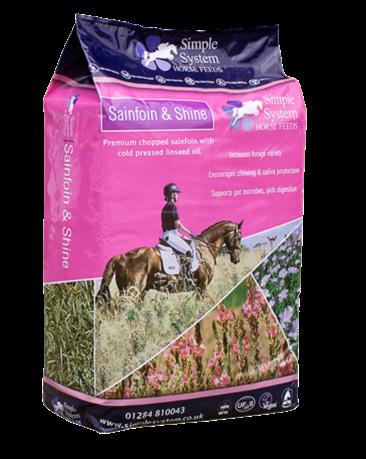
Contact the Feed Line for free advice and to find the very best feed for your horse’s individual needs.


01728 604 008 info@simplesystem.co.uk
Soaking hay is usually done to reduce sugar levels. The hay should be loosened from the bale and soaked in plenty of water. Using a haynet makes it easier, but do not have it tightly packed – the water needs to get in. There is no point in soaking hay if it is already low in sugar, so:
• Test the hay to ascertain how much sugar it has and if reducing it will be of benefit. Often, hay does not need to be soaked.
Sugar molecules are relatively small and will be extracted sooner than larger molecules. A significant reduction is achieved in less than an hour.
• To reduce sugar levels, do not soak for more than one hour and if hay is already low in sugar, 15-minutes may be sufficient.
Longer soaking removes further nutrition, including protein, a large proportion of minerals and vitamins and may even reduce fibre levels - all really important to the horse.
• Do not risk your horse’s health by prolonged soaking of hay. If you are soaking hay, make sure that protein and minerals are being topped-up elsewhere in the diet. Good quality hay can meet the vast majority of most horses’ nutritional requirements, but only if you don’t ruin it first.
Horses with respiratory issues can be very sensitive to dust, fungal spores and pollen. These small particles are inhaled deep into the lungs, causing a range of adverse reactions. For these horses, steaming may be a better option than soaking, as the hot steam ruptures the spores, rendering them harmless. Importantly, steaming preserves the hay’s nutritional value.
• Consider steaming – instead of soaking - for horses with respiratory issues.
Any damp hay, soaked or steamed, should be fed promptly. The longer it is damp, the greater the chance of acid-generating bacteria proliferating.
The best way to help a horse lose weight when it is doing a little too well is to increase metabolic rate – exercise, no needless rugging, and not to deliver a diet which will result in malnutrition. Over-soaked hay and straw are not, and never will be, adequate nutrition sources, and they will not meet basic needs. Weight reduction based on a diet deficient in protein may result in a loss of muscle bulk and slow, or even no, loss of fat.
• Always ensure a diet is balanced for essential nutrition.
Finally, bear in mind that the water hay has been soaked in is a pollutant and should be disposed of into the sewage system, not land drainage.
The Simple System Feed Line are always happy to discuss your horse’s forage requirements. Call 01728 604 008, or email info@simplesystem.co.uk for friendly, free advice.

3 A balancing feed, specifically designed for those challenged by weight or metabolic issues
3 Natural plant-based ingredients, free from artificial additives and preservatives
3 Optimises blood sugar levels and aids insulin effectiveness Available in 10kg & 20kg bags



Feeding horses correctly throughout their lives plays a crucial role in their long term health and performance. While all horses require a well balanced diet at all times, their nutritional needs can change significantly throughout their lifetime.
A forage based diet centered around high quality hay, grazing and other forage sources, is essential for maintaining digestive health, supporting growth, fuelling performance and promoting longevity. By focusing on the right nutrition at every life stage, owners can help their horses stay healthy, active and youthful for as long as possible.
Feeding young horses for healthy, natural growth. Proper nutrition during a horse’s early years lays the foundation for a sound, long lived equine partner. Young horses require a diet that supports steady, controlled growth without promoting excessive weight gain or developmental issues, such as osteochondrosis (OCD). High quality forages such as sainfoin and lucerne are ideal for growing youngsters and will supply additional protein and calcium to support bone growth. Feeding a good quality forage balancer, such as Total Eclipse, is essential to top up on essential vitamins, minerals and omega 3 - all of which are crucial for skeletal development. Avoiding grain and concentrates will help to prevent rapid growth which can contribute to orthopaedic issues.

Meeting the demands of the working or competing horse. Forage plays a vital role in the diet for competition working horses, providing essential fibre, slow-release energy, and key nutrients to support performance and recovery. High quality forages such as lucerne, sainfoin and grass offer numerous benefits.
Lucerne is rich in digestible protein, calcium and essential amino acids, making it an excellent choice for muscle development, stamina and aiding in buffering stomach acid, reducing the risk of gastric ulcers.
Sainfoin, like lucerne, also contains good levels of digestible protein and amino acids. Sainfoin is rich in highly digestible fibre which will produce slow release energy. One of sainfoin’s stand out features is the unique condensed tannins - these can have a positive effect on gut health and can also aid the digestion of protein. Working horses often need to consume more calories. Sainfoin is known for being highly palatable to help to encourage consistent forage intake - even in the fussiest feeder!
Red Bag Grass Pellets are another good option for working horses. These are high in protein, digestible fibre and energy, producing a steady, slow release fuel source - ideal for maintaining condition and supporting stamina. They are rich in vitamins, minerals and amino acids.
Red Bag
Grass Pellets are ideal for working horses with high energy requirements
Feeding a good quality forage balancer will also be of benefit. FlexiBalance is a great option for horses in work, providing a top-up of essential vitamins, minerals, antioxidants and omega 3. These nutrients will support joint health, muscle recovery and help manage the wear and tear that comes with regular work.
Supporting the veteran or senior horse. As horses age their digestive efficiency declines. They may struggle to maintain weight, muscle mass, and even to process nutrients effectively.
Common challenges for the older horse include...
• Dental issues: worn or missing teeth can make chewing hay difficult, leading to weight loss and poor digestion. Soaked HayCare® addresses this issue and can be fed in ad lib quantities.
• Reduced nutrient absorption: Older horses may require higher levels of quality protein and other essential nutrients. A quality forage balancer, such as Veteran Balance +® will ensure that these are topped up.
• Metabolic changes: Older horses are more prone to conditions like Cushing’s disease (PPID) or Insulin Resistance (IR) which require careful management of sugar and starch intake. Low sugar, high fibre forage is key. Products such as soaked Lucie® Fibre Cubes, HayCare® and MetaSlim® are ideal for metabolic horses.
Providing plenty of soaked forage options throughout the day/night helps elderly horses maintain weight and digestive function, whilst also preventing boredom and stress. Hydration is also critical. Ensuring access to fresh clean water and offering hydrating soaked feeds, can help reduce the risks of impaction colic.
By ensuring that your horse’s nutritional demands are fully catered for at each stage of their life, you are giving them the best opportunity to remain happier and healthier well into their senior years.

A lifelong forage based diet benefits horses at every stage by...
• Supporting a healthy digestive system, reducing the risk of colic, ulcers and metabolic disorders.
• Maintaining joint and muscle health, providing slow release energy and essential nutrients without excess sugar and starch.
• Enhancing immune function, a well balanced forage based diet, rich in naturally occurring vitamins and minerals, will promote long term health and resilience.
• Encouraging natural foraging behaviour, which may prevent boredom, cribbing and other stereotypic behaviours.


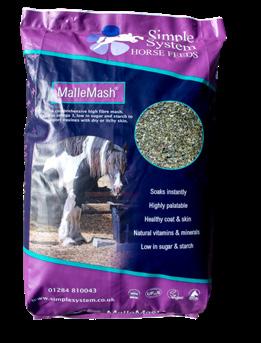
2. A natural buffer of acid (7)
3. Amazing things inside the horse’s gut (8)
5. Forage & freedom are missing some of these (7)
1. The horse, their diet and the rider, should all be (8)
4. Nature’s mineral supplement (7)
Hint - there’s an equestrian theme
1. This is made by the horse’s gut microbes 2. This is also made by the horse’s gut microbes
3. Sunlight is a source of...
4. Green grass provides...
5. Beta-carotene and Vitamin E are converted to...
6. Horses make this in their liver
7. The levels of this decline over time in even the best made hay
Can you match the statement with the correct answer?



